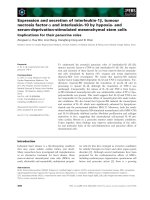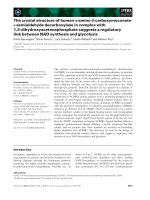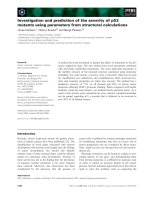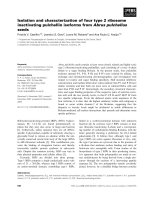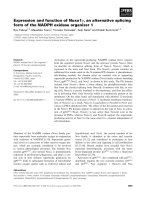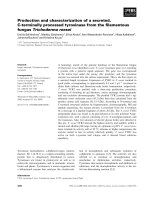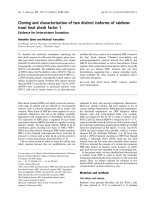Báo cáo khoa học: Mechanisms and kinetics of human arylamine N-acetyltransferase 1 inhibition by disulfiram potx
Bạn đang xem bản rút gọn của tài liệu. Xem và tải ngay bản đầy đủ của tài liệu tại đây (273.83 KB, 9 trang )
Mechanisms and kinetics of human arylamine
N-acetyltransferase 1 inhibition by disulfiram
Florence Malka, Julien Dairou, Nilusha Ragunathan, Jean-Marie Dupret and
Fernando Rodrigues-Lima
Universite
´
Paris Diderot-Paris 7, Unite
´
de Biologie Fonctionnelle et Adaptative (BFA), CNRS Equipe d’Accueil Conventione
´
e (EAC) 7059,
Laboratoire des Re
´
ponses Mole
´
culaires et Cellulaires aux Xe
´
nobiotiques, 75013, Paris, France
Introduction
Disulfiram (DS) or tetraethylthiuram disulfide (TTD)
(Antabuse
Ò
) has been used clinically in the treatment
of chronic alcoholism since 1948 [1] (Fig. 1). DS acts
by irreversibly inhibiting the hepatic aldehyde dehydro-
genase, leading to the accumulation of acetaldehydes
after alcohol ingestion [2]. The combined intake of DS
and ethanol provokes unpleasant reactions (nausea
and vomiting), which are the basis of the therapeutic
use of DS. Several studies have shown that DS inhibits
hepatic aldehyde dehydrogenase through covalent
modification of an active site cysteine residue [3]. New
potential therapeutic uses, in particular for human can-
cers and fungal infections, have been reported recently
for DS [4], indicating that the clinical applications of
this drug are broader than previously thought. Never-
theless, the mechanisms underlying these effects of DS
remain poorly understood.
DS is known to react with protein thiols to form
mixed disulfides or covalent adducts [3]. However,
many thiol-containing proteins do not react with DS,
indicating that covalent modification by this drug
shows marked specificity [5]. In addition to aldehyde
dehydrogenase, other enzymes have been reported to
be targeted by DS [6–8]. In particular, certain xeno-
biotic-metabolizing enzymes (XMEs), such as
cytochrome-P450 enzymes (CYP2E1) and glutathione
Keywords
arylamine N-acetyltransferase; cancer; drug
target; inhibition; kinetics
Correspondence
F. Rodrigues-Lima, Universite
´
Paris
Diderot-Paris 7, Unit of Functional and
Adaptative Biology (BFA) – CNRS EAC
7059, 75013 Paris, France
Fax: +33 1 57 27 83 29
Tel: +33 1 57 27 83 32
E-mail: fernando.rodrigues-lima@
univ-paris-diderot.fr
(Received 20 April 2009, revised 28 May
2009, accepted 1 July 2009)
doi:10.1111/j.1742-4658.2009.07189.x
Disulfiram has been used for decades to treat alcoholism. Its therapeutic
effect is thought to be mediated by the irreversible inhibition of aldehyde
dehydrogenase. Recent reports have indicated new therapeutic uses of
disulfiram, in particular in human cancers. Although the biochemical mech-
anisms that underlie these effects remain largely unknown, certain enzymes
involved in cancer processes have been reported to be targeted by disulfi-
ram. Arylamine N-acetyltransferase 1 (NAT1) is a xenobiotic-metabolizing
enzyme that biotransforms aromatic amine drugs and carcinogens. In addi-
tion to its role in xenobiotic metabolism, several studies have suggested
that NAT1 is involved in other physiological and ⁄ or pathological pro-
cesses, such as folate metabolism or cancer progression. In this report, we
provide evidence that human NAT1 is a new enzymatic target of disulfi-
ram. We found that disulfiram at clinically relevant concentrations impairs
the activity of endogenous NAT1 in human cancer cells. Further mechanis-
tic and kinetic studies indicated that disulfiram reacts irreversibly with the
active site cysteine residue of NAT1, leading to its rapid inhibition
(IC
50
= 3.3 ± 0.1 lm and k
i
=6· 10
4
m
)1
Æmin
)1
).
Abbreviations
AcCoA, acetyl-coenzyme A; DS, disulfiram; GSH, reduced glutathione; GST, glutathione S-transferase; IC
50,
half-maximal inhibitory
concentration; NAT, arylamine N-acetyltransferase; NAT1, arylamine N-acetyltransferase 1; PAS, p-aminosalicylic acid; PNPA,
p-nitrophenylacetate; TTD, tetraethylthiuram disulfide; XME, xenobiotic-metabolizing enzyme.
4900 FEBS Journal 276 (2009) 4900–4908 ª 2009 The Authors Journal compilation ª 2009 FEBS
S-transferase (GST), are impaired by DS with subse-
quent effects on xenobiotic metabolism in vivo [9–11].
Arylamine N-acetyltransferases (NATs) are phase 2
XMEs that catalyse the transfer of an acetyl group
from acetyl-coenzyme A (AcCoA) to the nitrogen or
oxygen atom of primary arylamines, hydrazines and
their N-hydroxylated metabolites [12]. NATs plays a
key role in the detoxification and ⁄ or activation of
numerous drugs and carcinogens [13]. In humans, two
functional isoforms, NAT1 and NAT2, have been
described [14]. Although their protein sequences are
similar (81% identical), their kinetic selectivity and
efficiency for aromatic substrates and tissue distribu-
tion differ markedly (NAT2 is found mainly in the
liver and intestinal epithelium, whereas NAT1 shows
widespread expression) [15,16]. Both NAT isoforms
are affected by genetic polymorphisms, which can be
a potential source of pharmacological and ⁄ or patho-
logical susceptibility [17]. In addition to the genetic
mechanisms that govern NAT expression and activity,
recent data have shown that NAT enzymes can be
affected by environmental chemicals, such as drugs or
pollutants [18]. More specifically, human NAT1 has
been shown to be impaired by oxidants [19–21] and
by certain therapeutic drugs, such as cisplatin [22]
and acetaminophen [23]. Several recent studies have
indicated that NAT1 may contribute to increased can-
cer risk and carcinogenesis [24–26], suggesting that
this XME could be relevant for cancer treatment
[27,28].
The identification and characterization of the molec-
ular targets of DS are of prime importance in order to
understand the pharmacological and ⁄ or toxicological
effects of this therapeutic compound. In this study, we
show that NAT1 is inhibited by therapeutic concentra-
tions of DS in vitro and in human cancer cells. Mecha-
nistic and kinetic analyses indicate that DS reacts with
the active site cysteine residue of NAT1, leading to the
irreversible inhibition of the enzyme, with a half-maxi-
mal inhibitory concentration (IC
50
) of 3.3 ± 0.1 lm
and a second-order inhibition rate constant (k
i
)of
6 · 10
4
m
)1
Æmin
)1
. Our work shows that NAT1 is a
new molecular target of DS.
Results
DS impairs the activity of NAT1 in human cancer
cells at clinically relevant concentrations
DS is well known to inhibit the activity of liver alde-
hyde dehydrogenase [2]. However, recent reports have
shown that DS may also react with other pro-
teins ⁄ enzymes, in particular in cancer cells [4,7,8,29].
The exposure of human lung cancer cells NCI-H292 to
therapeutically relevant concentrations of DS
( 30 lm) [4] led to the dose-dependent inhibition of
NAT1 (Fig. 2). Similar results were obtained with
another human lung cancer cell line (A549) (data not
shown). These data suggest that NAT1 may be a new
cellular target of DS.
Therapeutically relevant concentrations
of DS inhibit recombinant human NAT1 in an
irreversible and dose-dependent manner
To investigate the molecular mechanisms underlying
the DS-dependent inhibition of NAT1, we carried out
further biochemical and kinetic analyses using recom-
binant purified NAT1. To test whether DS inhibits
NAT1 directly, the recombinant enzyme was incubated
with different clinically relevant concentrations of the
drug and its residual activity was measured. As shown
in Figure 3, NAT1 was inhibited in a dose-dependent
manner by DS. Complete inhibition was observed with
0%
0 15 30 45
20%
40%
60%
80%
100%
120%
*
*
*
NAT activity (% of control)
[DS] (µM)
Fig. 2. Inhibition of endogenous NAT1 in human cancer cells by
clinically relevant concentrations of DS. NCI-H292 cells were
exposed to different concentrations of DS in NaCl ⁄ P
i
for 30 min at
37 °C. NAT1 activity was measured by HPLC in total cell extracts.
Extracts from untreated cells were used as controls. Enzyme activi-
ties were normalized with respect to protein concentration. Error
bars indicate the standard deviations (*P < 0.05). Similar results
were obtained with A549 cells (data not shown). An activity of
100% corresponds to a specific activity towards 2-aminofluorene of
10 ± 1 nmolÆmin
)1
Æmg
)1
.
N
S
S
S
N
S
Disulfiram (DS) or tetraethylthiuram disulfide (TTD)
Fig. 1. Chemical structure of DS.
F. Malka et al. Inhibition of NAT1 functions by disulfiram
FEBS Journal 276 (2009) 4900–4908 ª 2009 The Authors Journal compilation ª 2009 FEBS 4901
concentrations as low as 8 lm and the IC
50
value was
estimated to be equal to 3.3 ± 0.1 lm.
To test whether the DS-dependent inhibition of
NAT1 was irreversible, dialysis experiments were car-
ried out as described by Butcher et al. [30]. DS-treated
NAT1 showed a residual activity of only 12 ± 1%
and 3 ± 1% for dialysed and undialysed proteins,
respectively [100% activity corresponded to a specific
activity towards p-aminosalicylic acid (PAS) of
98 ± 7 nmolÆmin
)1
Æmg
)1
], suggesting the irreversible
inhibition of NAT1 by DS. Dialysis had no significant
effect on NAT1 activity, as also reported by Butcher
et al. [30].
We then investigated whether the DS-dependent
inhibition of NAT1 could be reversed by reducing
agents. As shown in Table 1, after inhibition by DS,
NAT1 activity could not be restored by physiological
concentrations of reduced glutathione (GSH) or by
high concentrations of the non-physiological reductant
dithiothreitol. These data suggest that the DS-depen-
dent inhibition of NAT1 is unlikely to be a result of
the formation of a mixed disulfide, but rather of the
formation of a stable DS adduct.
DS reacts with NAT1 thiol groups at therapeutic
concentrations
DS is a drug that reacts with thiols, and most of its
effects are probably a result of its affinity for sulfhy-
dryl groups in target proteins [3–5]. To test whether
therapeutic concentrations of DS react with the NAT1
cysteine residue, we incubated the purified enzyme with
DS in the concentration range shown to inhibit NAT1
(Fig. 3). Free unmodified cysteine residues in the
enzyme were labelled with fluorescein-conjugated
iodoacetamide and detected in western blots, as
described previously [31]. As shown in Figure 4, DS
reacted with NAT1 cysteine residues in a dose-depen-
dent manner, as indicated by the disappearance of the
fluorescein signal. This dose-dependent modification
was correlated with the dose-dependent inhibition of
0%
0 2 3 4 5
20%
40%
60%
80%
100%
120%
NAT1 activity
(
% of control
)
[DS] (µM)
*
*
*
*
Fig. 3. Dose-dependent inhibition of recombinant human NAT1 by
DS. NAT1 was incubated with clinically relevant concentrations of
DS in 25 m
M Tris ⁄ HCl, pH 7.5, 1 mM EDTA for 30 min at 37 °C.
NAT1 activity was then determined. Errors bars indicate standard
deviations (*P < 0.05). The results are presented as a percentage
of control activity (100% activity corresponds to a specific activity
towards PAS of 98 ± 7 nmolÆmin
)1
Æmg
)1
).
Table 1. Effects of reducing agents on DS-dependent inhibition of
NAT1.
Conditions % of control activity
a
NAT1 + DS 0.5 ± 0.7
NAT1 + DS + GSH (1 m
M) 1.2 ± 0.9
NAT1 + DS + GSH (2 m
M) 1.3 ± 0.6
NAT1 + DS + GSH (5 m
M) 1.9 ± 1.4
NAT1 + DS 0.4 ± 0.04
NAT1 + DS + DTT (1 m
M) 0.9 ± 0.1
NAT1 + DS + DTT (2 m
M) 1.4 ± 0.3
NAT1 + DS + DTT (5 m
M) 1.6 ± 0.3
a
100% activity corresponded to a specific activity towards PAS of
98 ± 7 nmolÆmin
)1
Æmg
)1
.
Fig. 4. Detection of the DS-dependent modification of NAT1 cyste-
ine residues. NAT1 was incubated with DS in 25 m
M Tris ⁄ HCl, pH
7.5, 1 m
M EDTA for 30 min at 37 °C. The reaction mixture was
incubated with fluorescein-conjugated iodoacetamide for 10 min at
37 °C. Samples were then subjected to SDS-PAGE under reducing
conditions, followed by western blotting using an anti-fluorescein
IgG (anti-fluorescein) or an anti-6 · His-tag IgG (anti-6 · Histag). For
the control (Ct), NAT1 was not treated with DS. Quantification of
the signals was carried out using
IMAGE J software (http://rsbweb.
nih.gov/ij/). The fluorescein intensity was normalized with respect
to the anti-6 · His-tag signal.
Inhibition of NAT1 functions by disulfiram F. Malka et al.
4902 FEBS Journal 276 (2009) 4900–4908 ª 2009 The Authors Journal compilation ª 2009 FEBS
NAT1 by DS (Fig. 2), suggesting that the processes
are linked.
DS-dependent inhibition of NAT1 involves
interactions with the active site
Among the five cysteine residues present in the
human NAT1 protein, one is localized in the enzyme
active site and is required for catalysis [32]. To test
whether the DS-dependent inhibition of NAT1 is a
result of reaction at the active site cysteine residue,
we carried out protection experiments in the presence
of the physiological acetyl donor AcCoA, as
described by Liu et al. [33]. This approach has been
largely used to identify whether the inhibition of
NAT enzymes by chemical compounds involves inter-
actions with the active site [33,34]. The incubation of
NAT1 with DS (8 lm) caused 93 ± 2% inhibition of
the enzyme, whereas the presence of AcCoA at 1 and
2mm decreased the extent of inhibition to 35 ± 5%
and 2 ± 4%, respectively (100% activity corre-
sponded to a specific activity towards PAS of
98 ± 7 nmolÆmin
)1
Æmg
)1
). These results suggest that
the DS-dependent inhibition of NAT1 is caused
by irreversible reaction with the active site cysteine
residue.
Kinetic analysis of the DS-dependent inhibition
of NAT1
We further analysed the inhibition of NAT1 by DS by
carrying out time course inhibition of the enzyme at
different DS concentrations. As shown in Figure 5A,
incubation of the enzyme with DS led to a monoexpo-
nential time-dependent loss of activity, indicating that
the inhibition reaction obeyed apparent first-order
kinetics. The apparent first-order inhibition constants
(k
obs
) were calculated for each concentration of DS.
The plot of k
obs
as a function of DS concentration fit-
ted well to a line passing at the origin (r
2
= 0.99)
(Fig. 5B), indicating that the inhibition of NAT1 by
DS occurs through a single-step bimolecular reaction.
The second-order rate constant for the inhibition of
NAT1 by DS (k
i
) was deduced from the slope of k
obs
as a function of the DS concentration [DS], and was
6 · 10
4
m
)1
Æmin
)1
. The order of the reaction of DS
with NAT1 (n) can be deduced from the equation
k
obs
= k
i
[DS]
n
, and can be calculated by plotting ln
k
obs
as a function of ln [DS] (Fig. 5C). Linear regres-
sion of these data indicated that they fitted well to a
line (r
2
= 0.99) with a slope (n) equal to 0.99, suggest-
ing that NAT1 inhibition by DS occurs through a
1 : 1 stoichiometry.
0.0
0.0 2.5 5.0 7.5
0.2
0.4
0.6
0.8
1.0
Relative residual activity
Time (min)
DS 0 µ
M
DS 4 µM
DS 6 µM
DS 8µM
0.0
0.1
0.2
0.3
0.4
0.5
0.6
[DS] (µ
M)
–1.6
–1.2
–0.8
R
2
= 0.997
R
2
= 0.999
–0.4
1.0 1.5
02468
2.0 2.5
ln (k
obs
) k
obs
(min
–1
)
ln ([DS])
A
B
C
Fig. 5. Kinetic analysis of the DS-induced inhibition of NAT1 activ-
ity. (A) NAT1 was incubated with various concentrations of DS in
25 m
M Tris ⁄ HCl, pH 7.5, 1 mM EDTA at 37 °C. At various short-time
intervals, aliquots were removed and assayed for residual activity.
Plots of the relative residual activity as a function of time are shown
and the data were found to fit well to a monoexponential time-
dependent process. The error bars indicate standard deviations. An
activity of 100% corresponds to a specific activity towards PAS of
98 ± 7 nmolÆmin
)1
Æmg
)1
. (B) The apparent first-order inhibition con-
stant (k
obs
) was calculated for each DS concentration and plotted.
The second-order inhibition constant (k
i
) was determined from the
slope and was 61 · 10
3
M
)1
Æmin
)1
. The error bars indicate standard
deviations. (C) To determine the stoichiometry of the reaction of DS
with NAT1, the natural logarithm (ln) of k
obs
was plotted as a func-
tion of ln [DS]. The slope was 0.99, indicating a 1 : 1 stoichiometry.
The error bars indicate standard deviations.
F. Malka et al. Inhibition of NAT1 functions by disulfiram
FEBS Journal 276 (2009) 4900–4908 ª 2009 The Authors Journal compilation ª 2009 FEBS 4903
Overall, our results suggest that DS-dependent inhi-
bition of NAT1 is caused by an irreversible single step.
This inhibition occurs in a competitive manner
through the modification of the active site catalytic
cysteine residue of NAT1 by DS.
Discussion
DS is an inhibitor of aldehyde dehydrogenase and is
currently being used clinically for the treatment of
alcoholism. Recent data suggest that DS could have
new therapeutic uses, particularly in cancer [4]. Inter-
estingly, DS was found to inhibit enzymes that have
been associated with cancer progression, such as DNA
topoisomerases, matrix metalloproteinases and protea-
some [6–8]. The biological effects of DS are now con-
sidered to involve different cellular pathways [4].
Therefore, the deciphering of new targets of DS may
help us to understand the therapeutic and toxicological
effects of this drug. In this article, we provide evidence
that the human XME NAT1 is a new target of DS.
We found that endogenous NAT1 expressed by two
human cancer cell lines was readily inhibited by
short-time exposure (30 min) to clinically relevant
concentrations of DS [4]. Interestingly, several studies
have associated NAT1 activity with an increased risk
of cancer [13]. In addition, recent data support the
suggestion that NAT1 may play a role in breast cancer
progression [16,27]. NAT1 expression has also been
shown to be increased by androgens in human prostate
cancer cells, which may have pathological implications
[25]. Overall, these studies suggest that NAT1 is a can-
cer-associated XME that could be targeted for cancer
treatment [16,27].
Mechanistic and kinetic analyses were carried out to
better understand the molecular basis for the DS-
dependent inhibition of NAT1 activity in cells. Our
data indicate that recombinant NAT1 was irreversibly
inhibited by low clinically relevant concentrations of
DS ( 30 lm) with an IC
50
value equal to
3.3 ± 0.1 lm. Recombinant aldehyde dehydrogenase
and DNA topoisomerases have been reported to be
inhibited in vitro in a similar manner with IC
50
values
close to 35 lm [6,35]. IC
50
values ranging from five to
hundreds of micromoles have been reported for differ-
ent GST isoforms [10]. Kinetic analysis has also shown
that the DS-dependent inhibition of NAT1 occurs
rapidly with a second-order rate constant of
6 · 10
4
m
)1
Æmin
)1
. Overall, these data suggest that DS
has an inhibitory potency against NAT1, similar to
that of known enzymatic DS targets.
DS is known to react with thiol groups, leading to
the formation of mixed disulfides or covalent adducts
on target proteins [3]. The inhibition of target
enzymes, such as aldehyde dehydrogenase, by DS
often occurs through the modification of an active site
cysteine residue [3]. Accordingly, our data (iodoaceta-
mide labelling, AcCoA protection assay and stoichi-
ometric analysis) indicate that the DS-dependent
inhibition of NAT1 is probably a result of the modifi-
cation of the cysteine residue present in the enzyme
active site. Reducing agents, such as GSH or dith-
iothreitol, used at high concentrations (up to 5 mm),
were unable to restore NAT1 activity. This suggests
that the DS-dependent inhibition of NAT1 is unlikely
to depend on the formation of a mixed disulfide
which is readily reduced by 1 mm dithiothreitol at
neutral pH, with subsequent recovery of enzymatic
activity, as observed for aldehyde dehydrogenase [3].
Indeed, contrary to aldehyde dehydrogenase, NAT1
does not possess two vicinal thiols in its active site
[36] and cannot thus be inhibited by the DS-depen-
dent formation of an intramolecular mixed disulfide
[3]. Therefore, the DS-dependent inhibition of NAT1
is probably the result of the formation of a stable DS
adduct that could be inaccessible to displacement by
thiol reagents [37]. Cisplatin, an anticancer drug, has
been reported recently to irreversibly inhibit NAT1
(k
i
= 700 m
)1
Æmin
)1
) in vivo and in vitro. This inhibi-
tion also occurs through the formation of an adduct
with the NAT1 active site cysteine, which cannot be
reduced by reducing agents [22]. Interestingly, the
reaction of DS with NAT1 occurs 87 times faster
(k
i
= 6.10
4
m
)1
Æmin
)1
) than the reaction of cisplatin
with the enzyme, thus supporting the suggestion that
NAT1 could be an in vivo target of DS. The human
NAT2 isoform shares a similar structure and mecha-
nism of action to human NAT1 [38]. This isoform is
thus likely to be inhibited by DS through the modifi-
cation of its catalytic cysteine. Further studies are
needed, however, to address whether DS reacts with
NAT1 and NAT2 in a similar manner. NAT2 metab-
olizes several aromatic amine drugs, such as isoniazid.
The inhibition of NAT2 by DS could lead to
drug–drug interactions as defects in NAT2 activity
are associated with isoniazid hepatotoxicity [39].
DS has been used for decades to treat alcoholism,
and its therapeutic activity is thought to be mediated
through the irreversible inhibition of aldehyde dehy-
drogenase. However, DS has been shown recently to
have new potential therapeutic applications [4].
Accordingly, the biochemical mechanisms and cellular
pathways that underlie the action of DS have also
begun to emerge with the identification of new pro-
tein targets of this drug [6–8]. Among them, XMEs
such as CYP 2E1 and certain GST isoforms have
Inhibition of NAT1 functions by disulfiram F. Malka et al.
4904 FEBS Journal 276 (2009) 4900–4908 ª 2009 The Authors Journal compilation ª 2009 FEBS
been shown to be inhibited by DS, with subsequent
effects in vivo on xenobiotic metabolism [9–11]. Our
data clearly indicate that the XME NAT1 could be a
new target of DS. In addition to its role in xenobi-
otic metabolism, there is increasing evidence to sug-
gest that NAT1 may also be involved in other
physiological and ⁄ or pathological processes, such as
folate metabolism [40,41] and cancer progression
[26,27]. The overexpression of NAT1 in normal lumi-
nal epithelial breast cells induced two of the hallmark
traits of cancer, i.e. enhanced growth and resistance
to certain therapeutic cytotoxic drugs used in cancer
treatment (etoposide) [42]. Recent studies from
Minchin et al. [25] have shown that NAT1 is induced
by androgens in human prostate cancer cells, with
possible implications for cancer risk. The increasing
evidence for an association of NAT1 with carcino-
genesis suggests that its inhibition could be used in
cancer therapy. The synthesis of small molecules that
inhibit NAT1 in breast cancer cells has been reported
recently [28]. The molecular mechanisms that underlie
the anti-cancer activity of DS remain poorly under-
stood. The DS-dependent inhibition of proteasome
and inactivation of ATF ⁄ CREB transcription factor
have been suggested to mediate DS anti-tumoral
activity [8,29]. However, the anti-cancer effects of DS
are probably a result of multiple mechanisms that
could act synergistically [4]. The DS-dependent
impairment of NAT1 could be one of these mecha-
nisms.
Experimental procedures
Materials
PAS, p-nitrophenylacetate (PNPA), AcCoA, DS (or TTD),
GSH and fluorescein-conjugated iodoacetamide were pur-
chased from Sigma (St-Quentin-Fallavier, France). Cell
culture reagents were from Invitrogen (Cergy-Pontoise,
France). Anti-fluorescein Fab¢ fragments conjugated to
peroxidase, monoclonal antibodies directed against His tag
and anti-mouse IgG were obtained from Roche (Meylan,
France). The Bradford protein assay kit was purchased
from Bio-Rad (Marne la Coquette, France). All other
reagents were obtained from Sigma, or Euromedex
(Souffelweyersheim, France).
Cell culture and exposure to DS
Human A549 lung carcinoma cells [43] and human NCI-
H292 pulmonary mucoepidermoid carcinoma cells [44] were
grown in DMEM ⁄ F12 medium supplemented with 10%
(v ⁄ v) fetal bovine serum, penicillin (100 UÆmL
)1
) and strep-
tomycin (100 lgÆmL
)1
). Cell monolayers (100 mm petri
dishes) were washed with NaCl ⁄ P
i
and exposed to different
concentrations of DS in 10 mL of NaCl ⁄ P
i
for 30 min at
37 °C. Controls were performed in the absence of DS. On
exposure, cells were washed with NaCl ⁄ P
i
and resuspended
in NaCl ⁄ P
i
containing 0.2% Triton X-100 supplemented
with protease inhibitors. Cells were sonicated and centri-
fuged for 15 min at 13 000 g. The supernatants were
removed, their protein concentration determined and
assayed for NAT1 activity using 2-aminofluorene.
Expression and purification of recombinant
human NAT1
Human NAT1 was expressed as a 6 · His-tagged protein in
Escherichia coli BL21 (DE3) cells transformed with a
pET28a-based plasmid, as described previously [31]. On
purification on nickel-agarose beads, recombinant NAT1
was reduced by incubation with 10 mm dithiothreitol for
10 min at 4 °C and dialysed against 25 mm Tris ⁄ HCl, pH
7.5. Purity was assessed by SDS-PAGE and protein concen-
trations were determined using the Bradford reagent follow-
ing the manufacturer’s instructions with bovine serum
albumin as a standard.
Enzyme assays
Recombinant NAT1 enzyme activity was determined spec-
trophotometrically using PNPA as the acetyl donor and
PAS as the arylamine substrate [45]. Briefly, treated or
untreated samples containing NAT1 enzyme were assayed
in a reaction mixture containing PAS (final concentration,
500 lm)in25mm Tris ⁄ HCl, pH 7.5, 1 mm EDTA. Reac-
tions were started by the addition of PNPA (final concen-
tration, 2 mm). In all reaction mixtures, the final
concentration of NAT1 was 115 nm. The reaction mixtures
was incubated for up to 15 min at 37 °C, and the reaction
was then quenched by the addition of SDS (final concentra-
tion, 2%). P-Nitrophenol, generated by the NAT1-medi-
ated hydrolysis of PNPA in the presence of PAS, was
quantified by measuring the absorbance at 410 nm [Biotek
(Colmar, France) microplate reader]. For the controls, we
omitted the enzyme or PAS. All enzyme reactions were per-
formed in triplicate in conditions in which the initial rates
were linear. Enzymes activities are shown as percentages of
control NAT1 activity.
NAT1 activity was measured in cell extracts using
reverse-phase HPLC, as described previously [14]. Samples
(25 lL) were mixed with the aromatic amine substrate
2-aminofluorene (final concentration, 1 mm) in assay buffer
(25 mm Tris ⁄ HCl, pH 7.5) at 37 °C. AcCoA (final concen-
tration, 1 mm) was added to start the reaction, and the
samples were incubated at 37 °C for various periods of time
(up to 20 min). The reaction was quenched by the addition
of 200 lL of ice-cold aqueous perchlorate (15% w ⁄ v), and
F. Malka et al. Inhibition of NAT1 functions by disulfiram
FEBS Journal 276 (2009) 4900–4908 ª 2009 The Authors Journal compilation ª 2009 FEBS 4905
proteins were recovered by centrifugation for 5 min at
12 000 g;20lL of the supernatant was injected onto a C18
reverse-phase HPLC column. All assays were performed
under initial reaction rate conditions. Enzyme activities
were normalized according to the protein concentration of
cellular extracts determined using a Bio-Rad protein assay
kit.
Reaction of recombinant NAT1 with DS
We assessed the effect of DS on NAT1 enzyme activity by
the incubation of purified NAT1 samples (final concentra-
tion of 75 lgÆmL
)1
with a specific activity towards PAS of
98 ± 7 nmolÆmin
)1
Æmg
)1
) with various concentrations of
DS (up to a final concentration of 8 lm )in25mm
Tris ⁄ HCl, pH 7.5, 1 mm EDTA for 30 min. Mixtures were
then assayed for NAT1 activity as described above.
To test whether the reaction of DS with NAT1 was irre-
versible, the recombinant enzyme was incubated with DS
(final concentration, 8 lm), and the mixture was dialysed
against 25 mm Tris ⁄ HCl, pH 7.5, 1 mm EDTA, for 4 h at
4 °C. Control assays were performed with untreated NAT1
and gave 100% NAT1 activity.
To test whether the DS-dependent inhibition of NAT1
activity could be reversed by reducing agents, NAT1 (final
concentration, 75 lgÆmL
)1
; specific activity towards PAS of
98 nmolÆmin
)1
Æmg
)1
) was first inhibited by DS (final con-
centration, 8 lm) for 20 min at 37 °C. The mixture was
then incubated for 10 min at 37 °C with various concentra-
tions of GSH or dithiothreitol (final concentrations up to
5mm). A NAT1 enzyme assay was then carried out. Assays
performed in these conditions, but without DS, gave 100%
NAT1 activity.
In substrate (AcCoA) protection experiments, NAT1
(final concentration, 75 lgÆmL
)1
; specific activity towards
PAS of 98 ± 7 nmolÆmin
)1
Æmg
)1
) was incubated with DS
(final concentration, 8 lm) in the presence of various con-
centrations of AcCoA (final concentrations up to 2 mm)
for 30 min at 37 °Cin25mm Tris ⁄ HCl, pH 7.5, 1 mm
EDTA. Samples were then assayed. Assays performed in
these conditions with AcCoA alone gave 100% NAT1
activity.
For the kinetic analysis of DS-mediated NAT1 inhibi-
tion, NAT1 (final concentration, 75 lgÆmL
)1
; specific activ-
ity towards PAS of 98 ± 775 nmolÆmin
)1
Æmg
)1
) was
incubated with different concentrations of DS (final concen-
tration up to 8 lm)at37°Cin25mm Tris ⁄ HCl, pH 7.5,
1mm EDTA. At various time intervals, aliquots were
removed and assayed for residual activity. The equation for
the rate of inhibition of recombinant NAT1 by DS can be
represented as – d[NAT1] ⁄ dt = k
i
[NAT1][DS], where
[NAT1] is the concentration of active enzyme and k
i
is the
second-order inhibition rate constant. The apparent
first-order inhibition rate constants (k
obs
= k
i
[DS]) can be
calculated for each DS concentration from the slope of the
natural logarithm of the percentage residual activity plotted
against time. The second-order rate constant was deter-
mined from the slope of k
obs
plotted against DS concen-
tration.
Fluorescein-conjugated iodoacetamide labelling
of NAT1 cysteine residues
Purified NAT1 (final concentration, 75 lgÆmL
)1
; specific
activity towards PAS of 98 ± 7 nmolÆ min
)1
Æmg
)1
) was pre-
incubated with or without (control, Ct) various concentra-
tions of DS (up to a final concentration of 8 lm)in25mm
Tris ⁄ HCl, pH 7.5, 1 mm EDTA for 30 min at 37 °C. Sam-
ples were incubated with fluorescein-conjugated iodoaceta-
mide (final concentration, 20 lm) for 10 min at 37 °C.
Samples were then analysed by SDS-PAGE under reducing
conditions, followed by western blotting, using anti-fluores-
cein Fab¢ fragments conjugated to peroxidase. Samples
were also analysed by western blotting with monoclonal
antibodies directed against 6 · His tag.
Protein determination, SDS-PAGE and western
blotting
Protein concentrations were determined using a Bradford
assay (Bio-Rad). Samples were combined with reducing
SDS sample buffer and separated by SDS-PAGE. Gels
were stained with Coomassie Brilliant Blue R-250. To
detect proteins labelled by fluorescein-conjugated iodoaceta-
mide in western blots, anti-fluorescein Fab¢ fragments con-
jugated to horseradish peroxidase (1 : 50 000) were used.
To control protein loading, the same membrane was
stripped by incubation for 1 h at 37 °C with stripping buf-
fer (20 mm Tris ⁄ HCl, pH 7.5, 20% SDS, 2 mm dithiothrei-
tol) and probed with anti-monoclonal anti-His IgG
(1 : 10 000).
Statistical analysis
The data are the means ± standard deviation of at least
two independent experiments performed in triplicate, unless
otherwise stated. One-way analysis of variance (anova) was
performed and followed by Student’s t-test (unpaired
and paired) between two groups using statview 5.0 (SAS
Institute Inc., Cary, NC, USA).
Acknowledgements
This work was supported by Agence Franc¸ aise de
Se
´
curite
´
Sanitaire de l’Environnement et du Travail
(AFSSET), Association pour la Recherche sur le Can-
cer (ARC), Leg Poix (Chancellerie des Universite
´
sde
Paris), Association Franc¸ aise contre les Myopathies
Inhibition of NAT1 functions by disulfiram F. Malka et al.
4906 FEBS Journal 276 (2009) 4900–4908 ª 2009 The Authors Journal compilation ª 2009 FEBS
(AFM) and Universite
´
Paris Diderot-Paris 7. We
thank Emile Petit for growing the cells.
References
1 Hald J & Jacobsen E (1948) A drug sensitizing the
organism to ethyl alcohol. Lancet 2, 1001–1004.
2 Lipsky JJ, Shen ML & Naylor S (2001) In vivo inhibi-
tion of aldehyde dehydrogenase by disulfiram. Chem
Biol Interact 130–132, 93–102.
3 Veverka KA, Johnson KL, Mays DC, Lipsky JJ &
Naylor S (1997) Inhibition of aldehyde dehydrogenase
by disulfiram and its metabolite methyl diethylthiocar-
bamoyl-sulfoxide. Biochem Pharmacol 53, 511–518.
4 Sauna ZE, Shukla S & Ambudkar SV (2005) Disulfi-
ram, an old drug with new potential therapeutic uses
for human cancers and fungal infections. Mol Biosyst 1,
127–134.
5 Vallari RC & Pietruszko R (1982) Human aldehyde
dehydrogenase: mechanism of inhibition of disulfiram.
Science 216, 637–639.
6 Yakisich JS, Siden A, Eneroth P & Cruz M (2001)
Disulfiram is a potent in vitro inhibitor of DNA topoi-
somerases. Biochem Biophys Res Commun 289, 586–590.
7 Shian SG, Kao YR, Wu FY & Wu CW (2003) Inhibi-
tion of invasion and angiogenesis by zinc-chelating
agent disulfiram. Mol Pharmacol 64, 1076–1084.
8 Chen D, Cui QC, Yang H & Dou QP (2006) Disulfi-
ram, a clinically used anti-alcoholism drug and copper-
binding agent, induces apoptotic cell death in breast
cancer cultures and xenografts via inhibition of the
proteasome activity. Cancer Res 66, 10425–10433.
9 van Bladeren PJ, Hoogeterp JJ, Breimer DD & van der
Gen A (1981) The influence of disulfiram and other
inhibitors of oxidative metabolism on the formation of
2-hydroxyethyl-mercapturic acid from 1,2-dibromoe-
thane by the rat. Biochem Pharmacol 30, 2983–2987.
10 Ploemen JP, van Iersel ML, Wormhoudt LW, Com-
mandeur JN, Vermeulen NP & Van Bladeren PJ (1996)
In vitro inhibition of rat and human glutathione
S-transferase isoenzymes by disulfiram and diet-
hyldithiocarbamate. Biochem Pharmacol 52, 197–204.
11 Frye RF & Branch RA (2002) Effect of chronic disulfi-
ram administration on the activities of CYP1A2,
CYP2C19, CYP2D6, CYP2E1, and N-acetyltransferase
in healthy human subjects. Br J Clin Pharmacol 53,
155–162.
12 Dupret JM & Rodrigues-Lima F (2005) Structure and
regulation of the drug-metabolizing enzymes arylamine
N-acetyltransferases. Curr Med Chem 12, 311–318.
13 Hein D (2002) Molecular genetics and function of
NAT1 and NAT2: role in aromatic amine metabolism
and carcinogenesis. Mutat Res 65, 506–507.
14 Grant DM, Blum M, Beer M & Meyer UA (1991)
Monomorphic and polymorphic human arylamine
N-acetyltransferases: a comparison of liver isozymes
and expressed products of two cloned genes. Mol
Pharmacol 39, 184–191.
15 Rodrigues-Lima F, Cooper R, Goudeau B, Atmane N,
Chamagne A, Butler-Browne G, Sim E, Vicart P &
Dupret J (2003) Skeletal muscles express the xenobiotic-
metabolizing enzyme arylamine N-acetyltransferase.
J Histochem Cytochem 51, 789–796.
16 Sim E, Westwood I & Fullam E (2007) Arylamine
N-acetyltransferases. Expert Opin Drug Metab Toxicol
3, 169–184.
17 Hein DW, Doll MA, Fretland AJ, Leff MA, Webb SJ,
Xiao GH, Devanaboyina US, Nangju NA & Feng Y
(2000) Molecular genetics and epidemiology of the
NAT1 and NAT2 acetylation polymorphisms. Cancer
Epidemiol Biomarkers Prev 9, 29–42.
18 Rodrigues-Lima F, Dairou J & Dupret JM (2008)
Effect of environmental substances on the activity of
arylamine N-acetyltransferases. Curr Drug Metab 9,
505–509.
19 Atmane N, Dairou J, Paul A, Dupret JM & Rodrigues-
Lima F (2003) Redox regulation of the human xenobi-
otic metabolizing enzyme arylamine N-acetyltransferase
1 (NAT1). Reversible inactivation by hydrogen perox-
ide. J Biol Chem 278, 35086–35092.
20 Rodrigues-Lima F & Dupret JM (2004) Regulation of
the activity of the human drug metabolizing enzyme
arylamine N-acetyltransferase 1: role of genetic and
non genetic factors. Curr Pharm Des 10, 2519–2524.
21 Dairou J, Malecaze F, Dupret JM & Rodrigues-Lima F
(2005) The xenobiotic-metabolizing enzymes arylamine
N-acetyltransferases (NAT) in human lens epithelial
cells: inactivation by cellular oxidants and UVB-induced
oxidative stress. Mol Pharmacol 67, 1299–1306.
22 Ragunathan N, Dairou J, Pluvinage B, Martins M,
Petit E, Janel N, Dupret JM & Rodrigues-Lima F
(2008) Identification of the xenobiotic-metabolizing
enzyme arylamine N-acetyltransferase 1 (NAT1) as a
new target of cisplatin in breast cancer cells: molecular
and cellular mechanisms of inhibition. Mol Pharmacol
73, 1761–1768.
23 Rothen JP, Haefeli WE, Meyer UA, Todesco L &
Wenk M (1998) Acetaminophen is an inhibitor of hepa-
tic N-acetyltransferase 2 in vitro and in vivo. Pharmaco-
genetics 8, 553–559.
24 Minchin RF, Hanna PE, Dupret JM, Wagner CR,
Rodrigues-Lima F & Butcher NJ (2007) Arylamine
N-acetyltransferase I. Int J Biochem Cell Biol 39,
1999–2005.
25 Butcher NJ, Tetlow NL, Cheung C, Broadhurst GM
& Minchin RF (2007) Induction of human arylamine
N-acetyltransferase type I by androgens in human
prostate cancer cells. Cancer Res 67, 85–92.
26 Wakefield L, Robinson J, Long H, Ibbitt JC,
Cooke S, Hurst HC & Sim E (2008) Arylamine
F. Malka et al. Inhibition of NAT1 functions by disulfiram
FEBS Journal 276 (2009) 4900–4908 ª 2009 The Authors Journal compilation ª 2009 FEBS 4907
N-acetyltransferase 1 expression in breast cancer cell
lines: a potential marker in estrogen receptor-positive
tumors. Genes Chromosomes Cancer 47, 118–126.
27 Sim E, Walters K & Boukouvala S (2008) Arylamine
N-acetyltransferases: from structure to function. Drug
Metab Rev 40, 479–510.
28 Russell AJ, Westwood IM, Crawford MH, Robinson J,
Kawamura A, Redfield C, Laurieri N, Lowe ED,
Davies SG & Sim E (2009) Selective small molecule
inhibitors of the potential breast cancer marker, human
arylamine N-acetyltransferase 1, and its murine homo-
logue, mouse arylamine N-acetyltransferase 2. Bioorg
Med Chem 17, 905–918.
29 Brar SS, Grigg C, Wilson KS, Holder WD Jr, Dreau
D, Austin C, Foster M, Ghio AJ, Whorton AR, Stowell
GW et al. (2004) Disulfiram inhibits activating tran-
scription factor ⁄ cyclic AMP-responsive element binding
protein and human melanoma growth in a metal-depen-
dent manner in vitro, in mice and in a patient with
metastatic disease. Mol Cancer Ther 3, 1049–1060.
30 Butcher NJ, Ilett KF & Minchin RF (2000) Inactivation
of human arylamine N-acetyltransferase 1 by the
hydroxylamine of p-aminobenzoic acid. Biochem
Pharmacol 60, 1829–1836.
31 Dairou J, Atmane N, Rodrigues-Lima F & Dupret JM
(2004) Peroxynitrite irreversibly inactivates the human
xenobiotic-metabolizing enzyme arylamine N-acetyl-
transferase 1 (NAT1) in human breast cancer cells. A
cellular and mechanistic study. J Biol Chem 279, 7708–
7714.
32 Dupret JM & Grant DM (1992) Site-directed mutagene-
sis of recombinant human arylamine N-acetyltransferase
expressed in Escherichia coli. Evidence for direct
involvement of Cys68 in the catalytic mechanism of
polymorphic human NAT2. J Biol Chem 267, 7381–
7385.
33 Liu L, Wagner CR & Hanna PE (2008) Human aryl-
amine N-acetyltransferase 1: in vitro and intracellular
inactivation by nitrosoarene metabolites of toxic and
carcinogenic arylamines. Chem Res Toxicol 21, 2005–
2016.
34 Andres HH, Klem AJ, Schopfer LM, Harrison JK &
Weber WW (1988) On the active site of liver acetyl-
CoA. Arylamine N-acetyltransferase from rapid acetyla-
tor rabbits. J Biol Chem 263, 7521–7527.
35 Lipsky JJ, Shen ML & Naylor S (2001) Overview –
in vitro inhibition of aldehyde dehydrogenase by
disulfiram and metabolites. Chem Biol Interact 130–132,
81–91.
36 Wu H, Dombrovsky L, Tempel W, Martin F, Loppnau
P, Goodfellow GH, Grant DM & Plotnikov AN (2007)
Structural basis of substrate-binding specificity of
human arylamine N-acetyltransferases. J Biol Chem
282, 30189–30197.
37 Kitson TM (1983) Mechanism of inactivation of sheep
liver cytoplasmic aldehyde dehydrogenase by disulfiram.
Biochem J 213, 551–554.
38 Dupret JM, Dairou J, Atmane N & Rodrigues-Lima F
(2005) Inactivation of human arylamine N-acetyltrans-
ferase 1 by hydrogen peroxide and peroxynitrite.
Methods Enzymol 400, 215–229.
39 Sim E, Lack N, Wang CJ, Long H, Westwood I,
Fullam E & Kawamura A (2008) Arylamine N-acety-
ltransferases: structural and functional implications of
polymorphisms. Toxicology 254, 170–183.
40 Minchin RF (1995) Acetylation of p-aminobenzoylglu-
tamate, a folic acid catabolite, by recombinant human
arylamine N-acetyltransferase and U937 cells. Biochem
J 307, 1–3.
41 Wakefield L, Cornish V, Long H, Griffiths WJ & Sim
E (2007) Deletion of a xenobiotic metabolizing gene in
mice affects folate metabolism. Biochem Biophys Res
Commun 364
, 556–560.
42 Adam PJ, Berry J, Loader JA, Tyson KL, Craggs G,
Smith P, De Belin J, Steers G, Pezzella F, Sachsenmeir
KF et al. (2003) Arylamine N-acetyltransferase-1 is
highly expressed in breast cancers and conveys
enhanced growth and resistance to etoposide in vitro.
Mol Cancer Res 1, 826–835.
43 Foster KA, Oster CG, Mayer MM, Avery ML &
Audus KL (1998) Characterization of the A549 cell line
as a type II pulmonary epithelial cell model for drug
metabolism. Exp Cell Res 243, 359–366.
44 Steiner P, Joynes C, Bassi R, Wang S, Tonra JR,
Hadari YR & Hicklin DJ (2007) Tumor growth inhibi-
tion with cetuximab and chemotherapy in non-small cell
lung cancer xenografts expressing wild-type and
mutated epidermal growth factor receptor. Clin Cancer
Res 13, 1540–1551.
45 Mushtaq A, Payton M & Sim E (2002) The C-terminus
of arylamine N-acetyl transferase from Salmonella
typhimurium controls enzymic activity. J Biol Chem
17, 12175–12181.
Inhibition of NAT1 functions by disulfiram F. Malka et al.
4908 FEBS Journal 276 (2009) 4900–4908 ª 2009 The Authors Journal compilation ª 2009 FEBS


